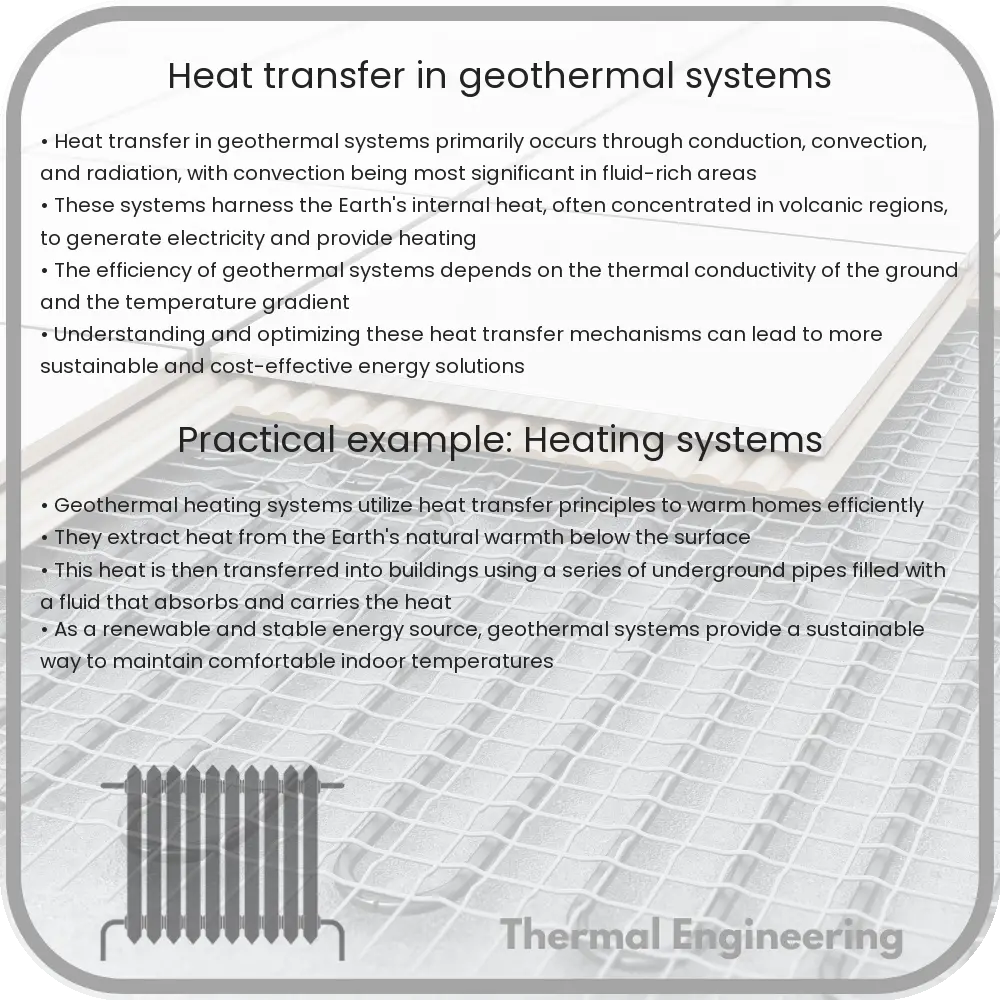Explore the principles of heat transfer in geothermal energy systems, focusing on conduction, convection, and radiation and their roles in optimizing system performance.

Understanding Heat Transfer in Geothermal Systems
Geothermal energy systems harness the Earth’s internal heat for practical applications such as heating buildings, generating electricity, and geothermal cooling. Central to the efficiency of these systems is the process of heat transfer, which is the movement of heat from one place to another. This article explores the basics of heat transfer within geothermal systems and how these principles are applied to extract and utilize Earth’s geothermal energy.
Types of Heat Transfer
There are three primary modes of heat transfer involved in geothermal systems:
- Conduction: This is the transfer of heat through a solid medium, such as rocks, when there is a temperature gradient. In geothermal systems, heat is conducted from the hot depths towards the cooler surface.
- Convection: Convection occurs when heat is carried away by moving fluids. In many geothermal systems, water or steam within the Earth moves because of heat; hot fluids rise, transfer heat, and cooler fluids sink, creating a convection cycle.
- Radiation: Radiation is the least significant in this context, as it involves the transfer of energy by electromagnetic waves and doesn’t require a medium for heat transfer. It is generally negligible in the solid crust but can be considered in theoretical models for completeness.
Modeling Heat Transfer in Geothermal Reservoirs
The performance of a geothermal system heavily depends on the rate of heat transfer, which is influenced by several factors:
- Thermal Conductivity of the Rock: Different rocks have varying abilities to conduct heat. For example, granite and basalt, common in geothermal reservoirs, have high thermal conductivities that facilitate heat transfer.
- Temperature Gradient: The gradient between the hot depths and cooler surfaces drives the heat flow. Typically, geothermal gradients are about 25°C per kilometer depth, although this can vary significantly.
- Fluid Properties: The type of fluid (water, steam, CO2) and its properties like density, viscosity, and specific heat capacity affect how heat is transported within the system.
- Permeability of the Rock: Rocks with higher permeability allow fluids to move more freely, thus enhancing the convective heat transfer component.
Applications and Techniques
Effective heat transfer mechanisms are essential for various applications of geothermal energy:
- Direct Use: In geothermally active regions, the heat can be used directly for heating buildings, agricultural applications, or industrial processes.
- Electricity Generation: Higher temperature systems (above 100°C) typically use the steam cycle to generate electricity. The steam extracted from the ground drives turbines connected to generators.
- Geothermal Heat Pumps: These systems utilize the constant temperatures near the Earth’s surface to cool and heat buildings. Geothermal heat pumps typically involve a heat exchanger and a fluid, which is circulated to transfer heat between the building and the ground.
Challenges and Developments
While geothermal systems are sustainable and environmentally friendly, they face challenges such as:
- Resource Location: High-grade geothermal resources are often located in geologically active regions, which can limit their availability and increase risks associated with their exploration and exploitation.
- Scaling and Corrosion: The interaction between the hot geothermal fluids and the surrounding rock can lead to scaling and corrosion, potentially reducing the system’s lifetime and efficiency.
Advancements in drilling technology, materials science, and heat transfer modeling continue to improve the efficiency and feasibility of geothermal systems, broadening their adoption and application. Understanding the fundamental aspects of heat transfer within these systems is crucial for optimizing their performance and maximizing their potential in our energy mix.
By enhancing the knowledge of how heat transfers in geothermal systems, researchers and engineers can design better systems that tap into the Earth’s renewable heat resources more effectively, contributing to a sustainable energy future.